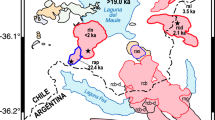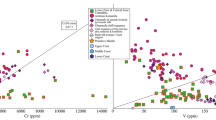Abstract.
The strong negative correlation between the temperatures and melt H2O contents of granitoid magmas implies that the crustal melting reactions that produced the magmas were strongly buffered, with T and aH2O co-varying within a narrow band. This observation can only be explained if the partial melting reactions that created the magmas were either fluid-absent from the outset or evolved toward this condition as melting progressed. Since these melting reactions occur during upper amphibolite- to granulite-facies metamorphism, it is reasonable to conclude that metamorphic events responsible for the generation of granitoid magmas generally occur in the absence of excess pervasive fluid.
Similar content being viewed by others
Author information
Authors and Affiliations
Additional information
Electronic Publication
Rights and permissions
About this article
Cite this article
Clemens, .J., Watkins, .J. The fluid regime of high-temperature metamorphism during granitoid magma genesis. Contrib Mineral Petrol 140, 600–606 (2001). https://doi.org/10.1007/s004100000205
Received:
Accepted:
Issue Date:
DOI: https://doi.org/10.1007/s004100000205




